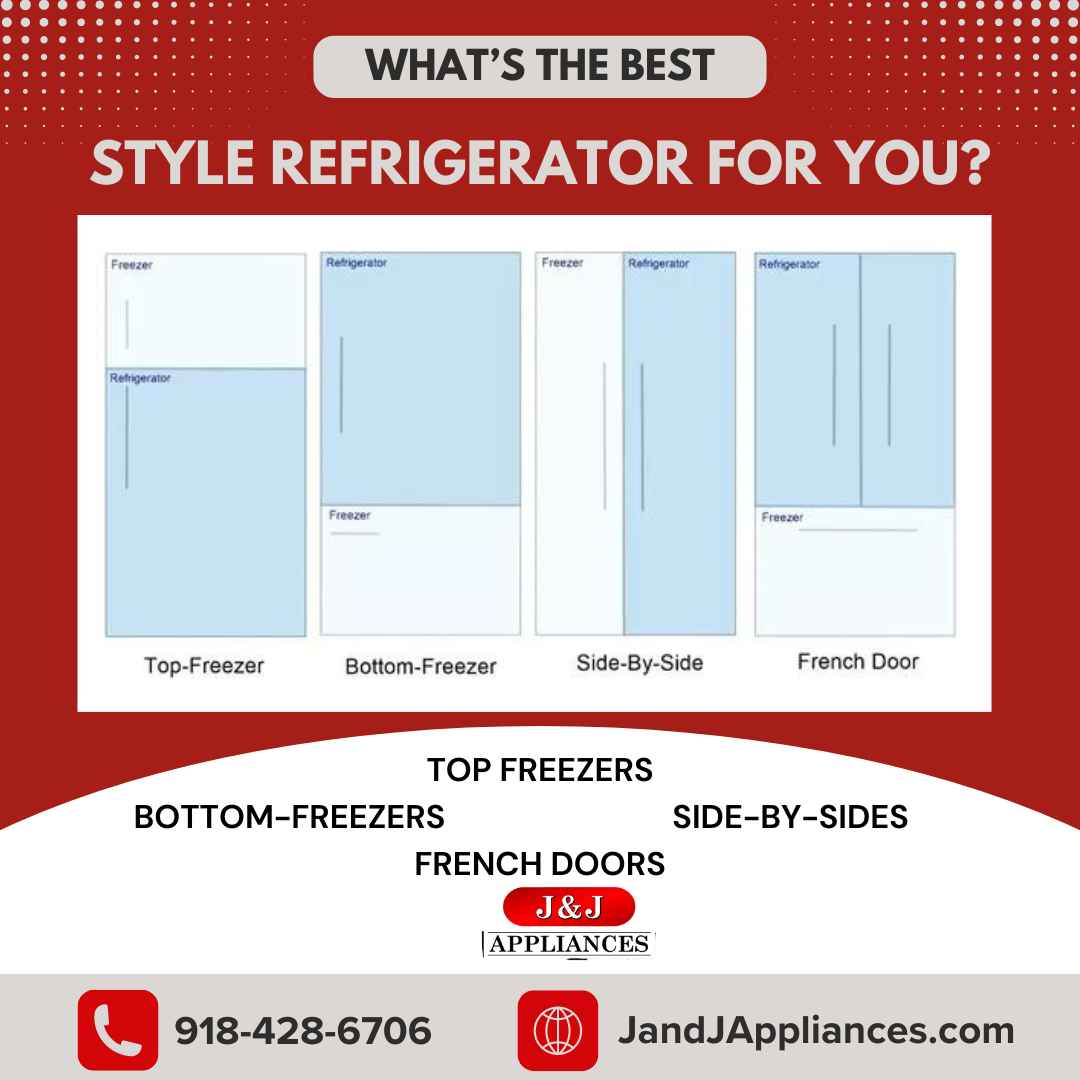If you’re in the market for a brand new refrigerator but you aren’t really sure what the best option is, good news - we’re going to look at each type of refrigerator you could get today!
First, we are going to illustrate the styles that each of these refrigerators will be available in.

As you can see from the illustrations above, the names are really quite explanatory. The top-freezer refrigerator (also referred to top-mount) has the freezer on the top of the unit, like the bottom-freezer refrigerator (also referred to bottom-mount) has the freezer on the bottom of the unit. These are refrigerators that you will generally see in rental units, as they tend to be on the lower end of the pricing spectrum. They are also available in smaller sizes, as well as some taller sizes, that you will not see in other styles.
The side-by-side refrigerator will always have the freezer portion on the left side of the unit and the refrigerator portion on the right . The french door is the only one of these that may have some type of variation to the refrigerator. The freezer will always be below the refrigerator and the refrigerator portion will always be on top top. The variation of this will insert a drawer unit that is between the two. Generally this is an adjustable drawer that can do anything from freezing temperatures up to wine holding temperatures.
Of the above styles, there will be options that you will choose depending on the space that you will be placing your refrigerator in.
Counter Depth:
This is going to be one of the most popular refrigerators out there. The reason for this is that it gives the unit an inset look within the cabinet where it is placed in your kitchen, as it does not protrude over the depth of your counter, which is generally around 30 inches or less. The upside of this style is the built-in look of the unit without the expense or electrical work of a built-in refrigerator. (More on built-ins later)

As you can see in the Bosch photo above, you have a French door style refrigerator, in counter depth, that has been installed into a kitchen. You can see the very finished look that you will achieve if you choose this type of refrigerator. The downside of this type of refrigerator is that your interior space will naturally have a smaller cubic foot measurement giving you less food storage space. Also, while the box portion of the refrigerator is counter depth, you will have the two or so inches of the doors that will stick out from the edge of the cabinet.
Counter depth refrigerators are all available in every configuration shown in the Illustration at the beginning of the blog except for a top freezer refrigerator.
Full Depth:
Full Depth refrigerators are popular with families, simply because they have more room to store food. This is the style I went with, as I do a lot of experimental fermentation, so I do enjoy the additional space where I can store things.
When placed in a kitchen, a full depth refrigerator will protrude from the space where it is placed, unlike the counter depth one above. They will average about 34 – 36 inches in depth, so quite a bit larger than the counter depth.

In an effort to illustrate how much this may protrude from your space, I created the image above. This is the refrigerator that I have in my home. The picture from GE on the left does not really show that protrusion, and I think that the main reason why is that a lot of people prefer to have their refrigerator appear flush to their cabinets and counter. On the right, you can see this protrusion on the refrigerator in my home. Again, for me this is worth it as I really do need the additional cubic square feet, which can differ by up to 5 or 6 cubic feet.
As with the counter depth, full depth refrigerators are available in every configuration shown in the Illustration at the beginning of the blog.
Built-In:
Built-in refrigerators are, as it says, built into your cabinetry, containing all electrical and plumbing as they are installed. (Traditionally, all other refrigerators that are not built-in are called free-standing.) They will always be counter depth as they are going to be flush with your cabinetry and counter. These refrigerators can be either panel ready, which means that they will be fit with custom built panels by your cabinet makers. When fit with panels, your refrigerator will virtually vanish into your kitchen and give a seamless look, as shown here.

They can also be fit with stainless steel, which come direct from the manufacturer. While the stainless-steel built-in refrigerator will not fade into your cabinetry, it will still appear flush and set into your cabinets. This gives your kitchen a much more professional kitchen look, very much like you would see in a restaurant. The image below shows a stainless-steel built-in refrigerator. There are also many built-ins that have stainless steel panels with in-set glass windows to view the contents.

Now, built-in refrigerators will only be available in the following configurations. Side-by-side, Bottom freezer, French door, all refrigerator and all freezer. There will not be an option for a top freezer refrigerator when it comes to a built-in. There are also many ways that a built-in refrigerator can be installed and how that will look as a finished product in your kitchen, which will be our next blog topic, so keep an eye out for that, coming very soon.
Each of these styles that we have outlined above are going be available from every manufacturer, aside from the built-ins. Generally, these built-in refrigerators are going to be available from the more luxury, or professional brands like, SubZero, Thermador, Monogram, Bosch and Signature Kitchen Suite, or SKS.
Overall there is no wrong choice, it is going to be completely up to you and what works for your kitchen and your family. If you know what you will be requiring in a refrigerator, please give Metropolitan Appliance a call or text so we can assist you in finding exactly what you and your kitchen wants!




